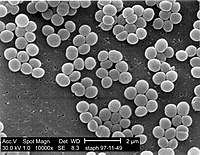
Photo from wikipedia
Staphylococcal Enterotoxins (SEs) are superantigens (SAg) originally produced by S. aureus, but their presence in coagulase negative staphylococci (CNS) has long been suspected. This study aims to better characterize a… Click to show full abstract
Staphylococcal Enterotoxins (SEs) are superantigens (SAg) originally produced by S. aureus, but their presence in coagulase negative staphylococci (CNS) has long been suspected. This study aims to better characterize a novel C-like enterotoxin expressed by clinical S. epidermidis strains, called SECepi. We isolated and characterized SECepi for its molecular and functional properties. The toxin was structurally modeled according to its significant similarity with S. aureus SEC3. Most of SEC amino acid residues important for the formation of the trimolecular Major Histocompatibility Complex II MHCII–SEC–T Cell Receptor TCR complex are conserved in SECepi. The functional properties of SECepi were estimated after cloning, expression in E. coli, and purification. The recombinant SECepi toxin exhibits biological characteristics of a SAg including stimulation of human T-cell mitogenicity, inducing and releasing high cytokines levels: IL-2, -4, -6, -8, -10, IFN-γ, TNF-α and GM-CSF at a dose as low as 3.7 pM. Compared to SECaureus, the production of pro-sepsis cytokine IL-6 is significantly higher with SECepi-activated lymphocytes. Furthermore, SECepi is stable to heat, pepsin or trypsin hydrolysis. The SECepi superantigen produced by CNS is functionally very close to that of S. aureus, possibly inducing a systemic inflammatory response at least comparable to that of SECaureus, and may account for S. epidermidis pathogenicity.
Journal Title: Toxins
Year Published: 2018
Link to full text (if available)
Share on Social Media: Sign Up to like & get
recommendations!